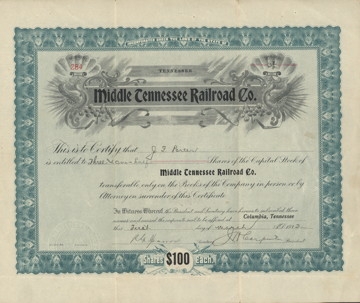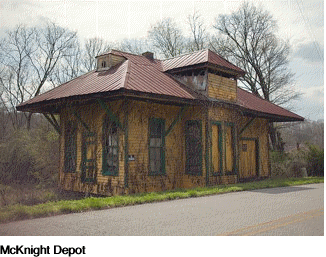 |
 |
|||

The onset of World War I gave all of the nation's railroads (including the Middle Tennessee) a brief surge of traffic, but this was no solution to his traffic dilemma. The railroad did carry a good amount of lumber and other forest products, as well as livestock, farm supplies and a smattering of passengers. Nearly all of this traffic was of a local nature, since the L&N possessed a parallel through route that robbed the Middle Tennessee of much of its potential traffic.
Early one morning in 1917, the residents of Boston, Tennessee, awoke to a strange noise. The morning northbound train from Mount Pleasant was nearing the station with its whistle cord tied down, so that the whistle sounded continuously. Figuring that something had to be up, several families hitched up teams and went down to the depot to see what in the world all the commotion was about. It was then that they received news that the United States had entered world War I.
 For a few months during World War I the Middle Tennessee Railroad, along with all of the rest of the railroads in the country, was operated by the United States Railway Administration (USRA). From January 1 to May l4, 1918 the federal government controlled nearly every aspect of railroading, mainly to relieve congestion in port cities and to help expedite the movement of defense shipments. This caused few troubles for the Middle Tennessee, as it had little business anyway, and very little even remotely connected with the war effort.
For a few months during World War I the Middle Tennessee Railroad, along with all of the rest of the railroads in the country, was operated by the United States Railway Administration (USRA). From January 1 to May l4, 1918 the federal government controlled nearly every aspect of railroading, mainly to relieve congestion in port cities and to help expedite the movement of defense shipments. This caused few troubles for the Middle Tennessee, as it had little business anyway, and very little even remotely connected with the war effort.
After the war had ended, a Franklin tomato cannery, operated by Martin Tohrner, that had a food contract with the government was still receiving carload after carload of tomatoes from the Middle Tennessee. Some government official had forgotten to cancel his food contract, leaving the cannery with a small mountain of rotting tomatoes to contend with.
After World War I, the railroad began to wind down. Several phosphate mines either reduced operations or closed down altogether. Also, the area served by the Middle Tennessee had gotten several good roads built by the state, thereby reducing the passenger revenue.
Defeated, Carpenter had to give up. On October 7, 1920, the Franklin Review Appeal carried the sad news that the Middle Tennessee Railroad was closing down:
“Last Thursday morning, orders were received by the local freight agent of the Middle Tennessee Railroad, Dave Donnelly, not to accept any more freight. These orders were issued following the action of the management of the road the preceding day, when, it is reported, they surrendered their charter as a steam road to the state. … What will be the outcome of the present situation is a matter of the purest conjecture, but it is one, too, in which Franklin and this section of the state are vitally concerned; and developments will be awaited with interest.”
So the trains of the Middle Tennessee were stilled. Considerable interest was kindled in keeping the railroad running in the immediate Franklin area to serve local industries, but nothing came of it.
The winter of 1920-1921 passed without a wheel turning on the Middle Tennessee tracks, and the Nashville Trust Company was designated to accept bids for the railroad. A deadline of January l, 1921 came and went with no bids offered. Subsequently, in September 1921, the entire railroad was auctioned off in front of the courthouse in Franklin. When the bids were announced, the high bid (and as it turned out, the only bid) was by none other than J.H. Carpenter, who offered $300,000 for the line.
This time Mr. Carpenter apparently had intentions of starting the line back up, but must have lacked the cash to get it running. The railroad was renamed as the Middle Tennessee Railway but remained dormant until well into 1922. At that time Mr. Carpenter purchased an odd-looking gasoline motor rail car that looked like a bus with railroad wheels.
This contraption was obtained from the Tennessee, Kentucky, & Northern Railroad (a short line in Overton County). Nicknamed “The Hucketybuck,” it ran passengers and small freight items between Franklin and Mount Pleasant. Regular freight trains apparently never operated again over the railroad, and its four locomotives were scattered to the winds on other railroads or sold for scrap.
The MTR’s Hucketybuck shouldn’t be confused with an L&N train with the same nickname that operated from Columbia to Florence, Ala.
When the rail bus was put into operation, Mr. Carpenter leased the Middle Tennessee Railway to the Nashville Interurban Railway so as to provide passenger service. The Hucketybuck was kept at Mount Pleasant and made a daily round trip to Franklin, connecting with the hourly interurban from there to Nashville.
Life with the Hucketybuck was as down home as Mike Howard's passenger trains of the previous decade. The railcar was so light — and the track so bad — that it often jumped the tracks. But since it was traveling at such a slow speed, these derailments were seldom more than minor holdups.
On one occasion as the daily accommodation approached Fly after a particularly heavy rain, the engineer noticed that a section of the roadbed had been washed out by the rising water of Leiper’s Creek. The track had slid down an embankment a few feet, and was jutting out over a raging torrent in the ditch below. Unconcerned, the engineer and the conductor leaned out the window, and decided to forge ahead. The railcar scooted across the track that was dangling in mid-air above the ditch while the amused passengers watched.
 Another time, the Hucketybuck derailed its front wheels on the high bridge over the Duck River and leaned over against the steel superstructure of the bridge. Undaunted, the passengers pitched in and helped the crew re-rail it, since it was obvious that the sooner they got things back on the track, the sooner they would get home.
Another time, the Hucketybuck derailed its front wheels on the high bridge over the Duck River and leaned over against the steel superstructure of the bridge. Undaunted, the passengers pitched in and helped the crew re-rail it, since it was obvious that the sooner they got things back on the track, the sooner they would get home.
This arrangement with the Nashville Interurban Railway lasted until 1928 when a trestle near the Duck River Bridge burned. Lacking the money to rebuild it (besides being way behind on property taxes), Carpenter decided to give up. ln July 1928, the railway filed with the Tennessee Railroad and Public Utilities Commission for permission to abandon and take up the track.
Carpenter had an offer by the Hyman-Michaels Company of Chicago to buy the rails, and he hoped that the sale of the rails and the land would satisfy the railroad's debts. Permission was subsequently granted, and track removal began that same year. The wrecking crew began its salvage operations on both sides of the burned trestle simultaneously, working in opposite directions away from the burned trestle.
The bridge over the Duck River was left in place at that time. All of the structures were torn down except for the station at McKnight, which still stands today [1986] in its same spot. Two miles of track were left intact at Franklin (most of this was the connecting track built between the Middle Tennessee and the L&N) to serve a rock quarry and a small phosphate mining operation southwest of town.
This was purchased by the L&N (now [CSX]) and became known as the Battlefield Branch, which is still in operation today [1986]. The Middle Tennessee Railroad's lone tunnel, on the Leatherwood Branch, was covered up recently by the construction of the Natchez Trace Parkway and is now inaccessible.
During World War II, as the national scrap metal drive was in full swing, someone remembered that the monstrous steel Duck River Bridge was still in place, rusting away. Subsequently, the U.S. Army Corps of Engineers appeared on the scene with explosives in hand ready to do the old bridge in.
Dynamite was set at strategic locations on the piers and abutments, and on signal a thunderous explosion sent the span to a watery grave in the murky water of the Duck River. Somebody miscalculated however, for the steel sections were wedged in between the piers on the river bottom and could not be economically retrieved. So the twisted steel scrap was left to rust in the river, with some of the pieces that jutted above the water level being cut off.
As nature began to reclaim the right-of-way of the Middle Tennessee Railroad, some of its assets were put to use. Much of the roadbed between Leiper's Fork and Water Valley became a county road, including several small bridges. In the hilly terrain, it looks somewhat strange to see a backwoods road so straight and level. The McKnight station made somebody a good hay barn.
So J. H. Carpenter's dream of a railroad empire ended there. The traffic just was not there in a large enough quantity to make the Middle Tennessee Railroad profitable. The fact that the railroad succumbed before the Great Depression when business as a whole was on a roll testified to the fact that it never had a chance.
Perhaps had the road been extended to Huntsville, it could have obtained enough through traffic to pay the bills. But the fact remains that Carpenter's railroad dreams fared no better than the submerged Duck River Bridge.
Page 3